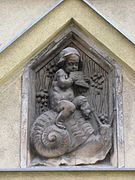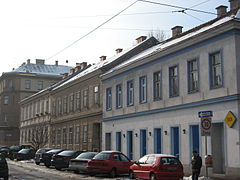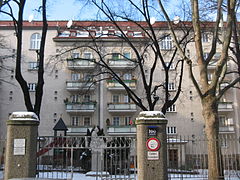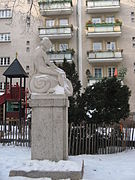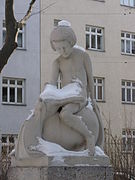Leebgasse
| Leebgasse | |
|---|---|
| Street in Vienna | |
| Basic data | |
| place | Vienna |
| District | Favoriten (10th district) |
| Hist. Names | Richardgasse |
| Cross streets | Landgutgasse, Dampfgasse, Hasengasse , Gudrunstraße , Erlachgasse, Pernerstorfergasse, Quellenstraße , Buchengasse , Rotenhofgasse, Davidgasse , Schröttergasse, Inzersdorfer Straße, Angeligasse , Hardtmuthgasse, Troststraße , Dieselgasse, Reichenbachgasse, Migerkastraße, Raxstraße |
| Places | Paltramplatz |
| use | |
| User groups | Pedestrians , bicycle traffic , car traffic |
| Road design | one way street |
| Technical specifications | |
| Street length | approx. 1809 m |
The Leebgasse located in the 10th Vienna district favorites . The street originally called Richardgasse was named after the Mayor of Vienna Anton Josef Leeb in 1894 .
Course and characteristics
Leebgasse begins at Landgutgasse and stretches uphill in a southerly direction to Raxstraße at the height of Wienerberg . It is run as a one-way street . There is no public transport on it, only between Gudrunstraße and Quellenstraße there are tram tracks to the Favoriten depot. The quiet Leebgasse connects the large thoroughfares Landgutgasse, Gudrunstraße, Quellenstraße, Troststraße and Raxstraße, which run in an east-west direction . Up to Troststraße there are still many old-favorite houses from the end of the 19th century, after which communal buildings from the interwar period dominate. The only small green area is touched on Paltramplatz .
Notable buildings
No. 17A and B: Health insurance of the Vienna public transport company
A large block between Gudrunstraße , Laxenburger Straße , Erlachgasse and Leebgasse is home to the Favoriten depot of Wiener Linien . Track systems from this remise also lead through Leebgasse (to Quellenstrasse). The health insurance company of Wiener Verkehrsbetriebe is located on Leebgasse, an elongated administrative building from the time of the First World War. The broad frontispiece and the economical decor are designed in the style of the Wiener Werkstätte . Above the two aedicula portals there are gable reliefs depicting puttos riding on a snail and a turtle. The building is a listed building .
No. 18 and 20: apartment buildings
These two buildings are located on the corner of Gudrunstraße and adjoining it. They have a remarkably rich historical decor for favorites. These are four-story apartment buildings from 1889 and 1892. House number 18 has a corner bay facing Gudrunstraße. The vestibules are structured pilasters and have colored stone tiles.
No. 30–32: Former lamp factory
The block between Pernerstorfergasse and Quellenstrasse is taken up by an extensive factory complex. Numbers 30–32 was a former lamp factory and department store, built by Carl Langhammer from 1898 and expanded at the beginning of the 20th century. A four-storey, block-shaped building in exposed brick rises around two courtyards, which is simply structured with continuous cornices. There is also a tall chimney made of bricks in the courtyard.
No. 34: Former sewing machine factory
In the same association as the former lamp factory, the former sewing machine factory and an associated residential building are located on the side of Quellenstrasse. The house was built in 1885 according to plans by Johann Sturany and is built in a strict historical style with a central bay window. The company property itself was rebuilt several times, has exposed brick facades with cornice structure and inside halls with cast iron girders.
No. 36, 38, 40: suburban apartment buildings
To the south of Quellenstrasse, there are still three two-storey suburban apartment buildings, rare in Favoriten, in simple, early historical forms.
No. 100: Margarethe-Hilferding-Hof
The residential complex of the municipality of Vienna was built in 1928–1929 according to plans by Franz Zabza . It has 107 residential units and is U-shaped around a courtyard that opens onto Leebgasse. A vertical structure of the facades is achieved by rows of balconies and bay windows. The representative building with its arched loggias is reminiscent of the Munich building school. In the courtyard there is a sculpture by Hugo Taglang from 1931, which shows a putto riding a snail. A memorial plaque commemorates Margarete Hilferding , a favorite doctor and district councilor, after whom the facility was named after the Second World War.
literature
- Federal Monuments Office (ed.): Dehio-Handbuch Wien. X. to XIX. and XXI. to XXIII. District . Publisher Anton Schroll: Vienna 1996
Web links
Coordinates: 48 ° 10 ′ 23.2 ″ N , 16 ° 22 ′ 10 ″ E




